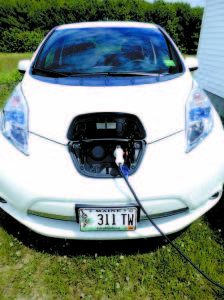Take a ride on the green side

A 2014 NISSAN LEAF — a 100% electric car, is plugged in and charging behind the Casco Town Office on Thursday. The town leased the demonstration vehicle from the Greater Portland Council of Governments. (De Busk Photo)
By Dawn De Busk
Staff Writer
CASCO — Does it seem like almost half the paycheck goes toward gas at the pumps?
It might be the high cost of gasoline that has some people investigating the electric vehicle technology. For others, it might be a concern for the environment — a way to reduce their share of pollution from carbon emissions as well as leaked engine oils. Whatever the reason, more and more people are purchasing electric cars.
In an effort to introduce electric vehicles to the public, the Town of Casco leased a demonstration model 2014 Nissan Leaf. The Leaf will be available for public viewing during Casco Days in July.
More importantly, residents voted at Town Meeting to install a few electric car-charging stations in their town. Voters determined that this addition to the budget was to stay within the $4,000 range.
At least three people drove the Leaf during the week that the town leased it from Greater Portland Council of Governments (GPCOG), according to Town Manager Dave Morton.
The most noticeable thing about the Leaf is what a person does not notice — noise. The engine is so quiet it is difficult to tell if it has been turned on.
“There is no engine noise. So, there is a backup alarm to let people know what the driver is doing since they cannot hear the engine running,†Morton said.
One thing people typically want to know is how many miles it can be driven after being fully-charged.
“It can go 34 miles,†Morton said.
“If I weren’t running the AC, it would get better mileage,†he said.
Basically, after he drove it to Casco from Portland, the car needed a charge. Morton said his typical driving habits take him within a radius of Casco. So hypothetically, an electric car would be a good option for him.
One evening last week, he drove the car home “and some folks walking down the road in the neighborhood stopped to talk about it. They were curious how it drove,†Morton said.
“I told them that it accelerates well,†he said.
“They said it was a larger car than they thought it would be,†he said.
Lots of people have that reaction, he said.
It is as roomy as most compact cars.
The battery that supplies energy to the car engine is located inside the vehicle, and should be replaced every 100,000 miles, he said.
There are three types of chargers. Level one takes about nine hours to sufficiently recharge the car. A level two recharger gets the car back on the road between three and four hours. Level three is priced much higher because it recharges an electric car in just two hours.
No grants are available to the town to offset the cost of the charging stations.
However, there are tax credits for private individuals who purchase an all-electric or hybrid electric vehicle, he said.
Morton said he had yet to research and compare installation costs for the charging stations.
“Right now, we really need to focus on the best locations for the chargers,†he said.
One likely location is Casco Village where the Casco Community Center, the library, the playground, and the tennis courts are located. The public beach on Pleasant Lake is also walkable from that area.
South Casco lacks town-owned property. Therefore, the town would likely to have to get the okay from a business owner along the Route 302 corridor.
Resident Peg Dilley said she has scouted out some other potential locations. In addition to the village, she suggested, “In South Casco where the old fire barn is near Maine Real Estate building. The town pays the electricity for a floodlight there. Another site is the land that is owned by the town on State Park Road.
Not only is electricity at available at those spots, but there are “locations to shop, swim, eat, see historic buildings nearby… activities that can keep people busy while they wait to charge,†Dilley said.
“These businesses could be helped by people waiting for a charge,†she said.
“Money made by charging for parking could be invested in the parking areas to keep them maintained,†she said.

